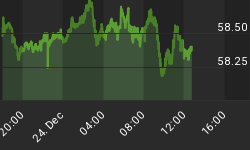Below is an excerpt from a commentary originally posted at www.speculative-investor.com on 24th February 2011.
Gold hit its intra-day correction low prior to the start of US trading on Friday 28th January, and then reversed upward. As we explained at the time, although Egypt's revolution was the catalyst for this directional change the gold market was primed for a reversal prior to this event. We noted, for example, that evidence in the form of the Commitments of Traders (COT) data and the Market Vane survey indicated that sentiment in the gold market prior to the 28th January reversal was roughly the same as it had been in mid July of 2010 -- just prior to the start of a relentless 2.5-month advance that resulted in a $200/oz addition to the gold price.
Market sentiment usually doesn't say much about future price direction, especially when considered in isolation. Sentiment generally just follows price, so it tends to be at its most useful as an indicator of future price direction in those cases where it doesn't mesh with the price action. Mismatches between price-action and sentiment -- for example, when sentiment becomes very negative even though the price action is positive or neutral -- aren't common, but when they do happen they are regularly followed by price moves in the opposite direction to the consensus expectation.
A sentiment mismatch is what we had in the gold market in late January, because even though there was no indication in gold's price action that anything other than a routine short-term correction was underway, it seemed that most market participants and commentators, including most long-term gold bulls, were convinced at the time that a much larger downturn was in progress. The scene was therefore set for a reversal.
The 28th January upward reversal was followed by a multi-week rally that added more than US$100 to the gold price. The bulk of this rally occurred without much 'help' from Middle-East instability, given that the financial markets had stopped worrying about Egypt by 1st February and didn't start worrying about the knock-on effects of the Libya uprising until the beginning of this week. During the intervening period, the US stock market pushed relentlessly upward as if there weren't a care in the world, the emerging markets focused on inflation threats and interest rate hikes, and the oil, T-Bond and currency markets did very little.
However, Middle-East instability moved back to centre-stage early this week due to dramatic escalation in the conflict between the people and the ruling class in Libya. Unlike Egypt, Libya is a significant oil exporter. Also, with yet another long-time Middle-East dictator seemingly about to be overthrown, the markets are being forced to re-assess the risk that the revolutionary wave will spread to the most important of the Middle East's oil producers (Saudi Arabia).
As we've noted many times in TSI commentaries over the years (most recently in our 31st January commentary), gains in the gold price made on the back of geopolitical events are never sustained. This week's Libya-fueled gains won't be an exception, but although the Middle East is the focal point du jour there are reasons to believe that gold could make significant additional upward progress over the weeks ahead even if the geopolitical backdrop were to become less threatening. One reason is that the silver/gold ratio is still ramping upward (silver/gold is dangerously 'overbought', but there won't be a problem until it either plunges or diverges bearishly from the gold price). Another is the recent downturn in the BKX/SPX ratio (the Bank Index relative to the broad stock market) illustrated by the following chart.
Relative weakness in the banking sector is bullish for gold, while relative strength in the banks is bearish. For example, it is probably not a fluke that gold's early-December peak followed on the heels of November's upward reversal in BKX/SPX. Therefore, if BKX/SPX's recent weakness is the start of a new trend then gold could maintain its upward bias regardless of events in the Middle East.

Gold's short-term risk/reward still looks bullish, but it has just risen for seven days in a row and is currently just below important resistance (refer to the following daily chart for details). The odds therefore favour a pullback.
Due to this week's gains we suspect that any pullback over the coming week will do no worse than take gold back to $1360-$1370. In fact, a daily close below $1360 from here on could be considered an early warning that a more bearish short-term scenario was beginning to unfold.

We aren't offering a free trial subscription at this time, but free samples of our work (excerpts from our regular commentaries) can be viewed at: http://www.speculative-investor.com/new/freesamples.html
















